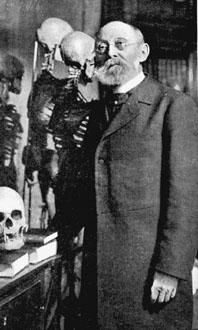

 | Page 1316 |  |
the nineteenth century. On the international level, he was one of the promoters of international geological congresses.
However, it was in prehistory that Vilanova y Piera’s research was its most innovative. He was the first naturalist full member of the Royal Academy of History, through his research activities and his diffusion of prehistory. His interest sprang from discussions with European geologists and through the association of Paleolithic industries with extinct fauna, which was also observed by Casiano del Prado on the banks of the river Manzanares in San Isidro, Madrid (1862). Vilanova y Piera was the author of two unique treaties on the prehistory of the Iberian Peninsula: Origen, naturaleza, y antigüedad del Hombre (The Origen, Nature, and Antiquity of Man)(1872) and, with Juan de Dios de la Rada Delgado, Geología y Protohistoria Ibéricas (The Geology and Protohistory of Iberia)(1894) in the Historia General de España edited by the Royal Academy of History. He also took part in all the congresses on archaeology and prehistoric anthropology that took place in Europe and in the associations aimed at achieving their institutionalization. By 1869, he was, along with J. F. M. Tubino, the official Spanish representative at the Copenhagen International Archaeology Congress.
In prehistory, Vilanova y Piera is associated with the introduction of a first Copper Age within the Metal Age and with the defense, even at the cost of his scientific credibility, of the authenticity of the altamira cave paintings discovered by Marcelino Sanz de Sautuola in 1879.
Throughout his life, Vilanova y Piera endeavored to incorporate European knowledge on the subjects with which he was involved into Spanish science and to present Spanish contributions to this knowledge at the different meetings and congresses that he attended abroad. His task had two main limitations. First, as a naturalist, the very extension of his work involved significant information gaps. Second, his religious attitudes, extreme on certain subjects such as evolution, reduced his objectivity in spite of his attempts to keep within the limits of science.
References
Gozalo Gutierrez, Rodolfo. 1993. “Biografía de Juan Vilanova y Piera.” In Homenaje a Juan Vilanova y Piera (Valencia, 25–27 de noviembre de 1993), 11–83. Valencia: Departamento de Geología Universitat de València, Servicio de Investigación Prehistórica Diputación de Valencia, Sociedad Económica de Amigos del País de Valencia.
(1821–1902)
Rudolf Virchow was born in Germany and educated at the University of Berlin, where he received his Ph.D. in medicine in 1843 and where he established an archive of anatomy and physiology. In 1849, Virchow became professor of pathological anatomy at the University of Würzburg, and in 1856, he returned to Berlin as professor of pathological anatomy and director of the newly created Pathological Institute, where he included lectures in prehistory in his courses.

Rudolf Virchow
(Ann Ronan Picture Library)
 |  |